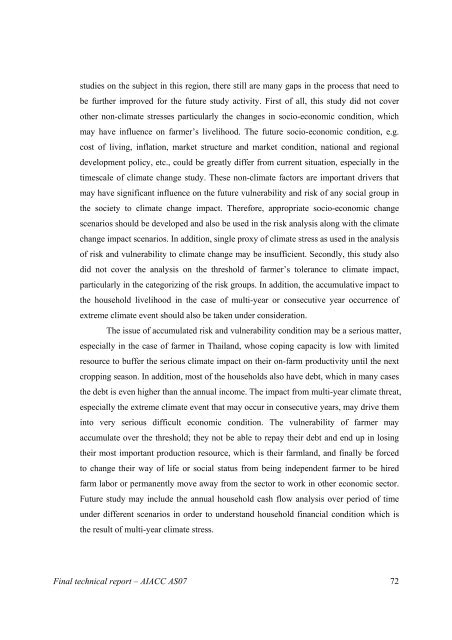Final Technical Report - weADAPT
Final Technical Report - weADAPT
Final Technical Report - weADAPT
- No tags were found...
Create successful ePaper yourself
Turn your PDF publications into a flip-book with our unique Google optimized e-Paper software.
studies on the subject in this region, there still are many gaps in the process that need to<br />
be further improved for the future study activity. First of all, this study did not cover<br />
other non-climate stresses particularly the changes in socio-economic condition, which<br />
may have influence on farmer’s livelihood. The future socio-economic condition, e.g.<br />
cost of living, inflation, market structure and market condition, national and regional<br />
development policy, etc., could be greatly differ from current situation, especially in the<br />
timescale of climate change study. These non-climate factors are important drivers that<br />
may have significant influence on the future vulnerability and risk of any social group in<br />
the society to climate change impact. Therefore, appropriate socio-economic change<br />
scenarios should be developed and also be used in the risk analysis along with the climate<br />
change impact scenarios. In addition, single proxy of climate stress as used in the analysis<br />
of risk and vulnerability to climate change may be insufficient. Secondly, this study also<br />
did not cover the analysis on the threshold of farmer’s tolerance to climate impact,<br />
particularly in the categorizing of the risk groups. In addition, the accumulative impact to<br />
the household livelihood in the case of multi-year or consecutive year occurrence of<br />
extreme climate event should also be taken under consideration.<br />
The issue of accumulated risk and vulnerability condition may be a serious matter,<br />
especially in the case of farmer in Thailand, whose coping capacity is low with limited<br />
resource to buffer the serious climate impact on their on-farm productivity until the next<br />
cropping season. In addition, most of the households also have debt, which in many cases<br />
the debt is even higher than the annual income. The impact from multi-year climate threat,<br />
especially the extreme climate event that may occur in consecutive years, may drive them<br />
into very serious difficult economic condition. The vulnerability of farmer may<br />
accumulate over the threshold; they not be able to repay their debt and end up in losing<br />
their most important production resource, which is their farmland, and finally be forced<br />
to change their way of life or social status from being independent farmer to be hired<br />
farm labor or permanently move away from the sector to work in other economic sector.<br />
Future study may include the annual household cash flow analysis over period of time<br />
under different scenarios in order to understand household financial condition which is<br />
the result of multi-year climate stress.<br />
<strong>Final</strong> technical report – AIACC AS07 72
















